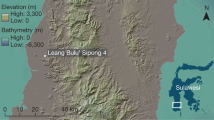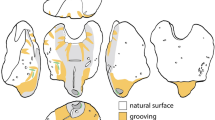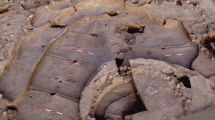Abstract
THE end of the Upper Palaeolithic and the subsequent Mesolithic of western Europe coincided with a general change of climate, flora and fauna. Throughout this time the nomadic hunters and food gatherers continued their former activities and perfected their techniques in a changing environment, before the introduction of agriculture and the change to a sedentary way of life. In Spain, this period is associated with a type of rock art known as ‘art of the Spanish Levant’, because it occurs only within a limited area of the mountainous coast of eastern Spain; it is provisionally dated approximately from 8,000 to 2,000 BC. Its outstanding features are the appearance of motion and the fact that the central figures are mainly human, around which animal figures are grouped. We report here a scene we discovered last year at one of the most important Levantine rock-art zones, the Barranco de la Valltorta (Castellon), which is a dried out, deep and eroded river bed. It shows wild honey gathering activities and depicts the first definite ladder constructed of side ropes, with visibly rigid intersecting rungs, which are straight and even, and which must be sticks prepared for this purpose.
This is a preview of subscription content, access via your institution
Access options
Subscribe to this journal
Receive 51 print issues and online access
$199.00 per year
only $3.90 per issue
Buy this article
- Purchase on Springer Link
- Instant access to full article PDF
Prices may be subject to local taxes which are calculated during checkout
Similar content being viewed by others
References
Cabre, J. Actas Mems Soc. esp. Antrop., Etnogr. Prehist. 23, 107–114 (1923).
Duran y Sanpere, A. & Maties Palares, S. Anu. Inst. Estud. Catalans 6, 444–457 (1915–20).
Hernandez-Pacheco, E. Mems. Com. Invest. paleont. prehist. 34, (1924).
Jorda Cerda, F. & Alcacer Grau, J. Mems. Serv. Invest, prehist. 15, (1953).
Obermaier, H. & Wernert, P. Mems. Com. Invest, paleont. prehist. 23, (1919).
Ortego, T. Arch. Esp. Arqueol. 21, 3–37 (1948).
Pager, H. Bee Wld 54(2), 61–68 (1973).
Pager, H. Bee Wld 57(1), 9–14 (1976).
Author information
Authors and Affiliations
Rights and permissions
About this article
Cite this article
DAMS, M., DAMS, L. Spanish rock art depicting honey gathering during the Mesolithic. Nature 268, 228–230 (1977). https://doi.org/10.1038/268228a0
Received:
Accepted:
Issue Date:
DOI: https://doi.org/10.1038/268228a0
This article is cited by
-
Human consumption of seaweed and freshwater aquatic plants in ancient Europe
Nature Communications (2023)
-
Honey compositional convergence and the parallel domestication of social bees
Scientific Reports (2022)
-
Widespread exploitation of the honeybee by early Neolithic farmers
Nature (2015)
Comments
By submitting a comment you agree to abide by our Terms and Community Guidelines. If you find something abusive or that does not comply with our terms or guidelines please flag it as inappropriate.



